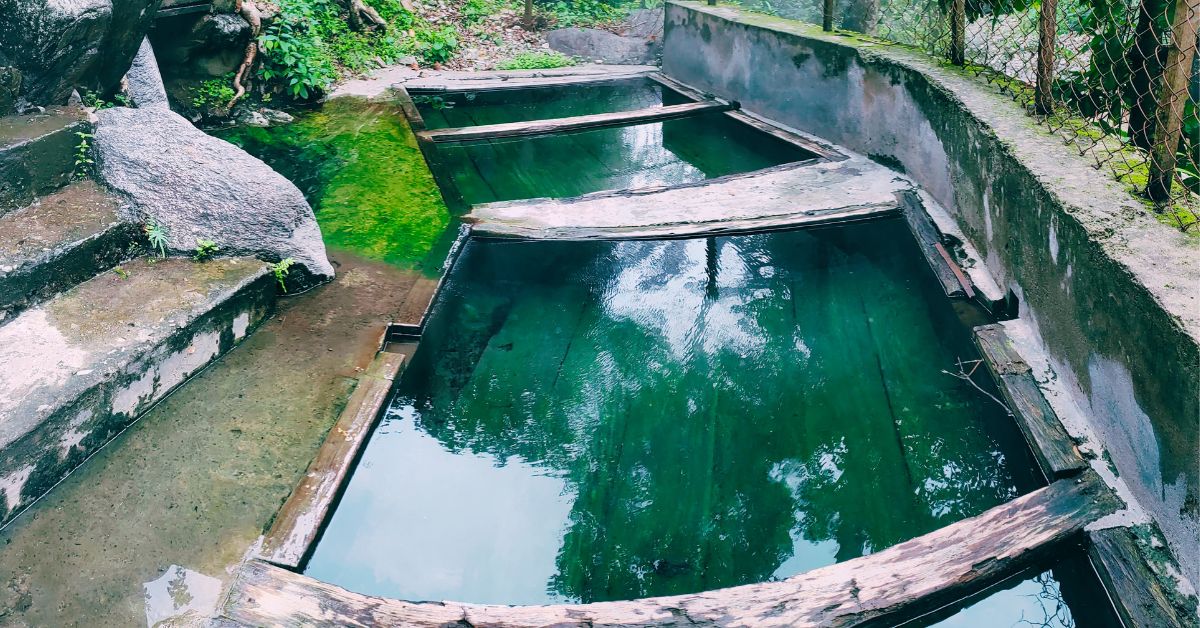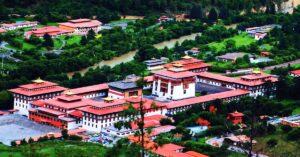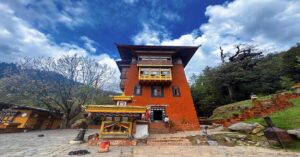Duenmang Tshachu is one of the hot springs in Bhutan. It is located on the right bank of the Mangdechhu at the base of a cliff of Kamjong Hill in Nangkor Gewog under Zhemgang Dzongkhag. It is widely known as the Kheng Tshachu due to its location in the center of the Kheng region at an elevation of 500 meters above sea level.
The Tshachu is located on government reserve forest land under the jurisdiction of the Zhemgang forest division under Nangkor Gewog. Bhutan has 10 hot springs.
The most popular hot springs in Bhutan are the Chubu hot spring in Punakha, the Koma hot Spring in Punakha, the Duenmang hot spring in Zhemgang, the Khempajong Nye hot spring in Lhuntse, the Gasa hot spring in Gasa, and the Gelephu hot spring in Sarpang.
Also Read: Hot Springs in Bhutan: Bhutanese Beliefs and Benefits
How to Reach Duenmang Tshachu
Duenmang Hot Spring is 75 Kilometers from Zhemgang and about 40 kilometers from Tingtibi satellite town. From Tingtibi town, drive to Gonphu. Gonphu town is around an hour’s drive from Tingtibi. From Gonphu, it takes about 45 minutes to an hour to trek to reach Duenmang Tshachu.
Duenmang Tshachu Hike: The hike starts from Praling on the Tingtibi-Panbang highway and takes an hour to reach the hot spring. Langurs along the trail are known to throw stones at travelers descending towards the Tshachu. But now, the foot trail from the road head at Praling to the Tshachu has been improved with steel railings, and the path from the bridge to the Tshachu has been roofed with wire mesh.
Also Read: How to Reach Gasa Tshachu
Trek Route of Duenmang Tsachu
- Start from Tingtibi Satellite town, Zhemgang;
- Tingtibi to Praling: 40 km and a 2-hour drive by car;
- Praling to Duenmang Tshachu: 1 hour walk.
The Origin of Duenmang Tshachu
No one knows the exact origin of Duenmang Tshachu, but it is believed that Guru Rinpoche blessed it as his Nye can be found there. The Duenmang Tshachu is said to have been discovered by a hunter who followed the footprints of wild animals.
According to legend, the Tshachu’s initial location was in the village of Kamjong. However, people there began tossing trash and animal corpses into the Tshachu to keep visitors away. Therefore, the Tshachu is believed to have moved to its present location. The Tshachu’s name gradually evolved to Duenmang Tshachu since the road to Duenmang village goes through the hot spring.
Also Read: The Origin of Dur Hot Spring in Bumthang
Description of Duenmang Tsachu
Duenmang Tshachu was officially recognized as Tshachu in 1972. The hot spring is crystal clear, surrounded by tall trees, and overlooks the emerald Mangde Chhu River. In addition to the original four, six more ponds have recently been constructed to meet the growing demand.
Pool 1 with a temperature of 40.7 °C is categorized as a warm spring, while Pool 2 with a temperature of 45.2 °C, Pool 3 with a temperature of 49 °C, and Pool 4 with a temperature of 43 °C are categorized as hot springs. The temperatures of other ponds are not measured.
The walkway inside the hot spring is protected by bars and has a canopy covering it.
Also Read: Description of Gelephu Tshachu
Therapeutic Values or Ethnopharmacological Benefits of Duenmang Tsachu
In Bhutan, hot springs are traditionally regarded as natural sources of healing. People from all over the country flock to the hot spring, hoping to heal physically and spiritually.
Kheng Duenmang Tshachu is a renowned hot spring with “great healing power”. Pool 1 is believed to heal indigestion, improve bodily heat, and cure phlegm disorders, gout, and a feeling of lameness in the limbs. This pool is frequently used by people seeking treatment for tuberculosis, goiters, joint pain, sinusitis, and skin diseases.
Pool 2 is said to heal complicated convulsions, remove bodily poisons, and alleviate chronic fevers and feelings of lameness in the limbs. Although Pool 3 has the same source as Pool 2 and thus has the same medicinal properties, people visit it to alleviate headaches. Pool 4 is used to heal skin diseases, though it has the same source as Pools 2 & 3 and thus has the same medicinal properties. Besides curing ailments, a soak in the hot spring is a great way to unwind day and a mineral treat for the body and mind.
Also Read: Therapeutic Values or Ethnopharmacological Benefits of Chubu Tshachu
Accommodation at Duenmang Tshachu
There is a government guest house and a three-story public guest house. The new guesthouse constructed by Zhemgang Forest Division has 10 rooms, each accommodating 10 persons. People can also stay in the attic. If you fail to get a room, you can pitch your tent and stay there as long as you want.
There are guesthouses, a neykhang (residence of a local deity), bathrooms, water taps, and waste bins in every corner of the area. You can contact the Dzongkhag administration to assist you in making a room reservation at the guest house.
Also Read: Accommodation at Koma Tshachu
Best Time to Visit Duenmang Tshachu
The Duenmang Tsachu is one of the most well-known hot springs in Bhutan. An increasing number of individuals are drawn to this hot spring. Annually, more than 1000 people visit Duenmang Hot Spring. The best time to visit Duenmang Tshachu is during the winter months from November to March. You can visit major hot springs in Bhutan with the Bhutan Pilgrimage Package.
Places to Explore in Zhemgang
Zhemgang Dzong: It is a fortress at the site of a hermitage founded by Lama Zhang Dorje Drakpa in 1163. It was built by Zhabdrung Rinpoche as a symbol of the unification of Khengrig Namsum in 1655.
Buli Tsho: It is a sacred lake revered as the palace of the protector goddess Tshomen Kuntu Zangmo, also known as Buli Moenmo, a mermaid guardian deity.
Trong Heritage Village: Traditional stone masonry houses on a hillock overlooking Zhemgang Dzong. It showcases Bhutanese architecture with earthquake-resistant techniques and cobbled pathways.
Wamling Gaden Tashicholing: It is a Buddhist monastery or institution, likely inspired by the Gaden tradition of Tibetan Buddhism, which emphasizes the teachings of Lama Je Tsong Khapa.
Enjoyed reading this blog?




